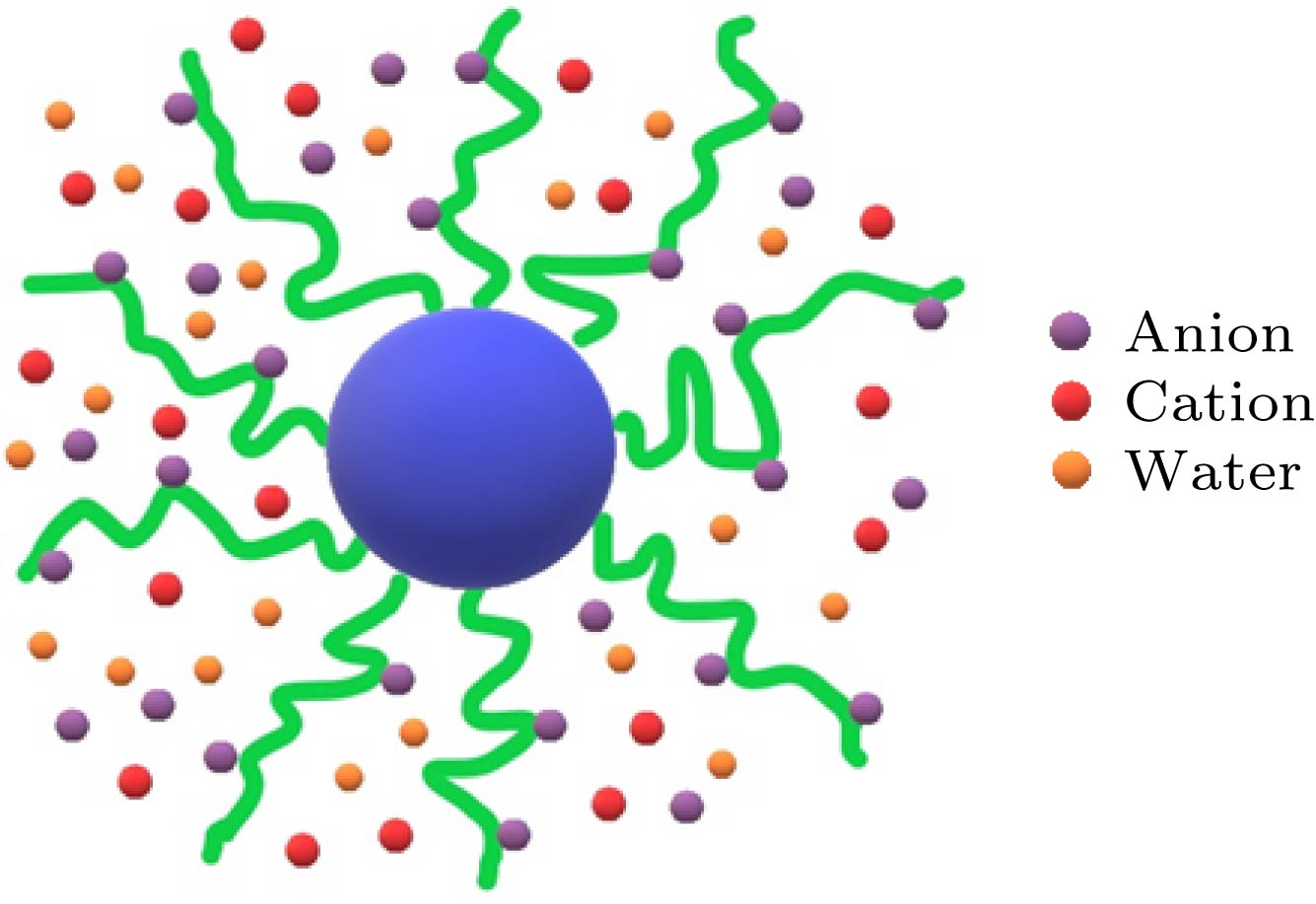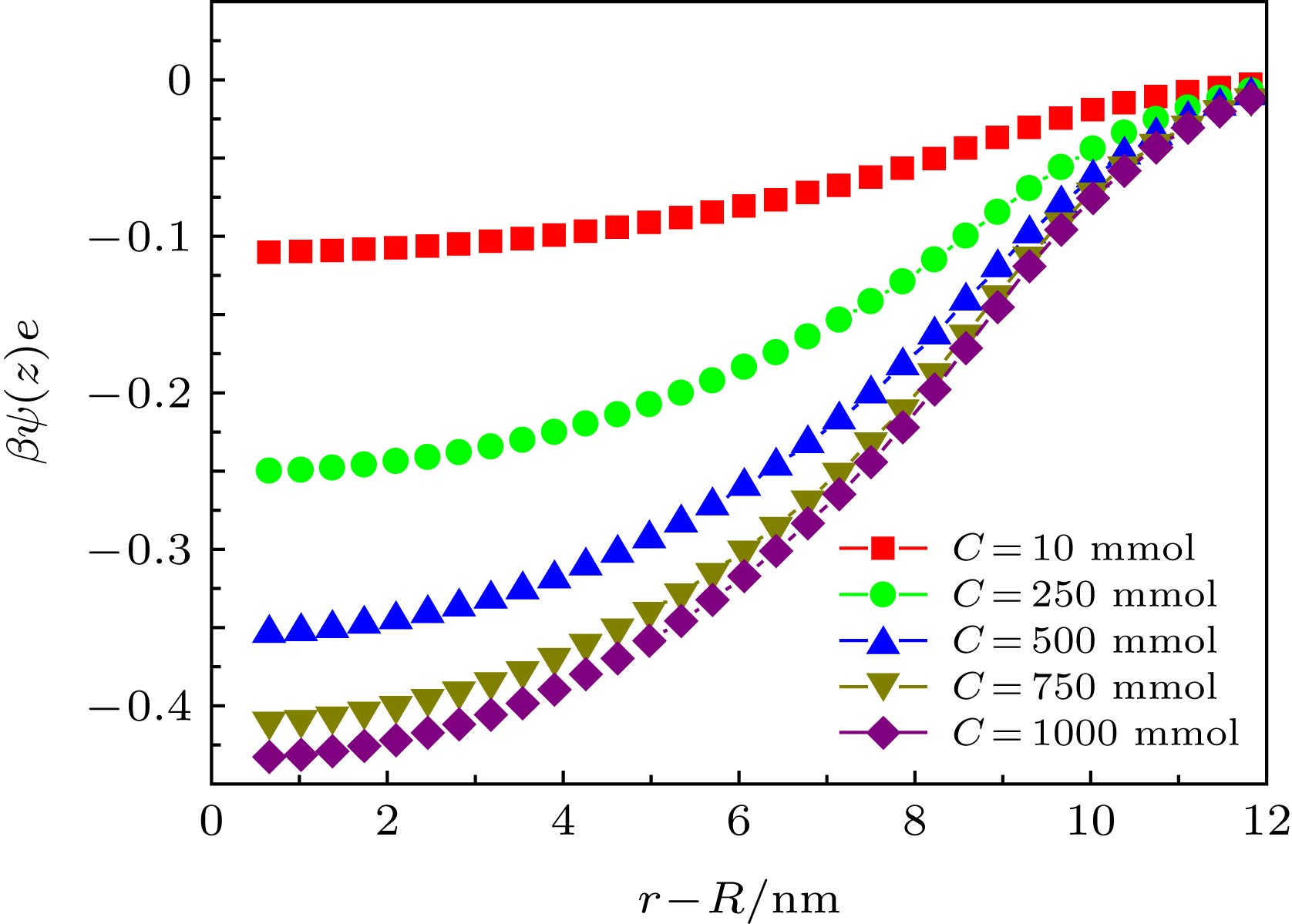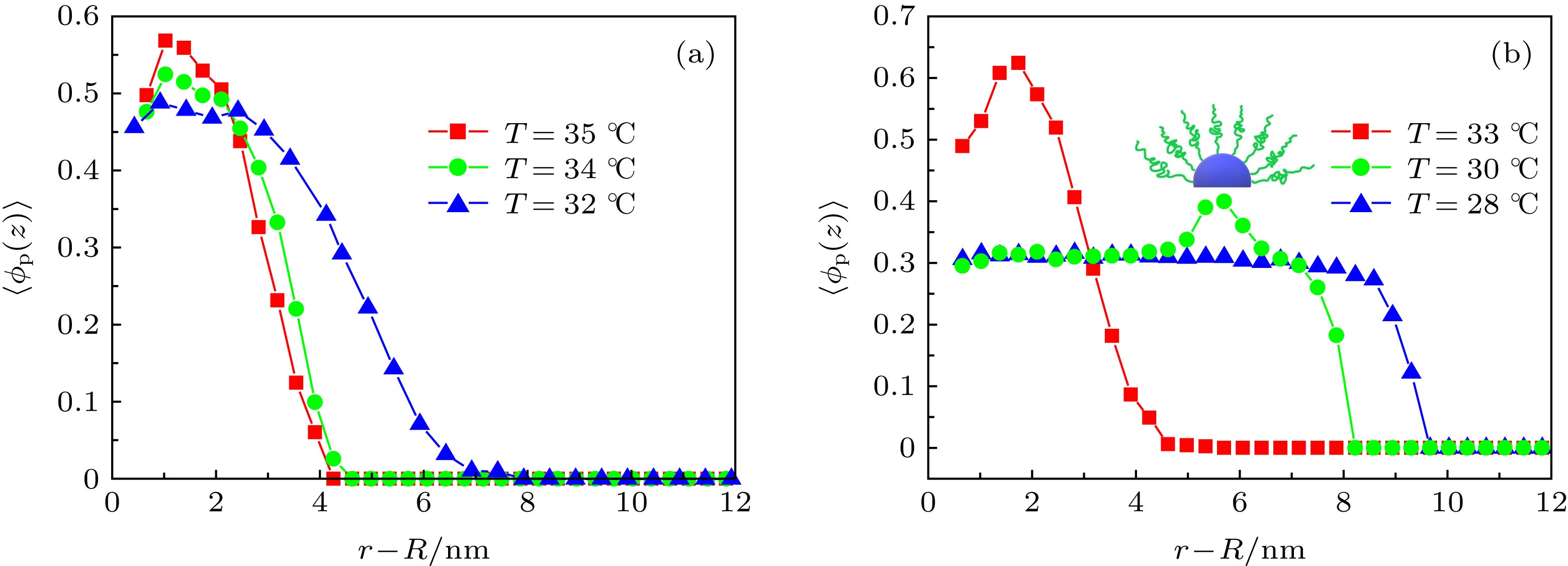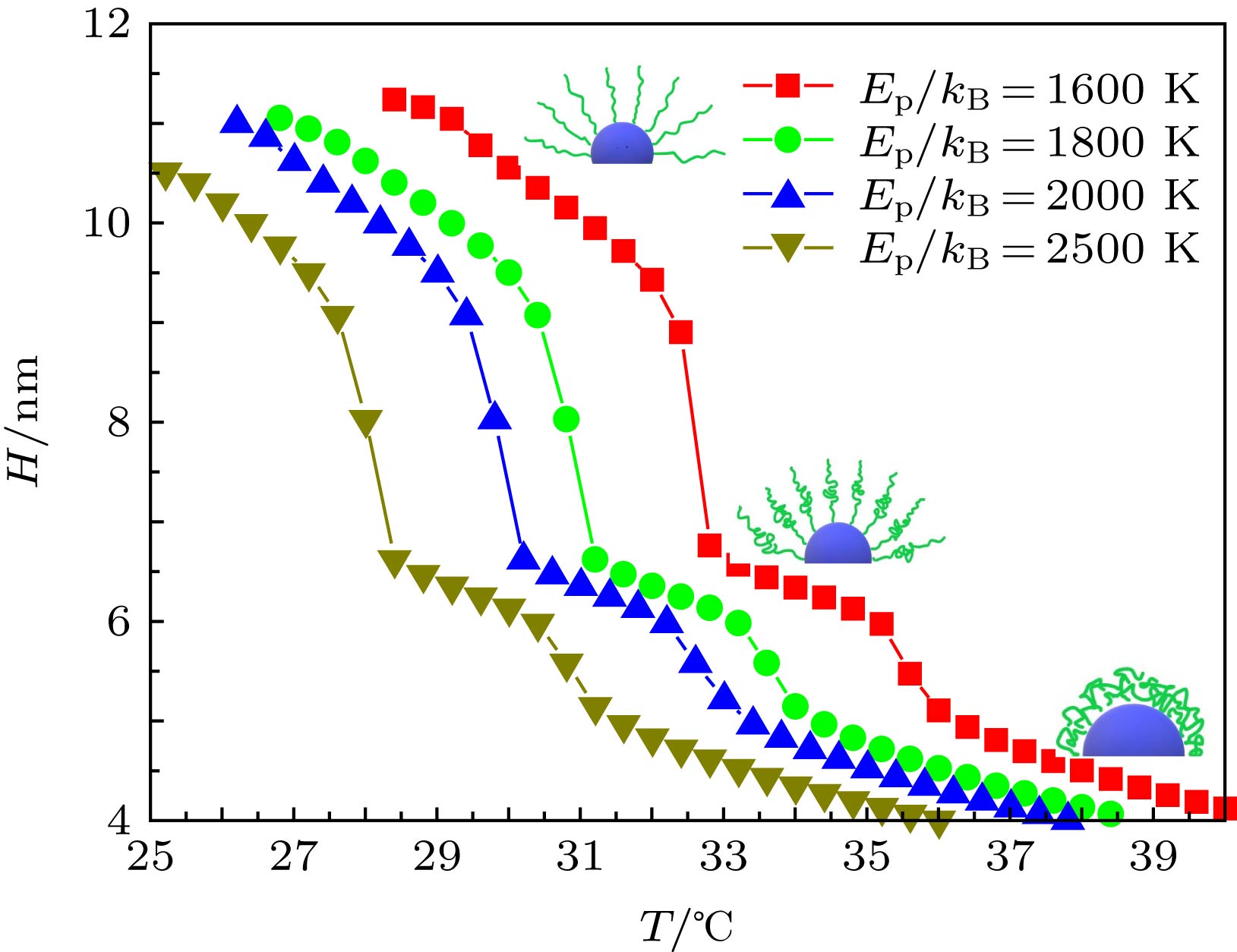-
应用分子场理论研究接枝在纳米粒子表面的聚异丙基丙烯酰胺(PNIPAM)球面刷构象转变中的硫氰酸根离子(SCN–)效应, 理论模型考虑PNIPAM-SCN–的结合(P—S键)和体系的静电特性. 研究发现, PNIPAM球面刷构象转变的低临界溶液温度(LCST)在较低SCN–浓度条件下, 随着SCN–浓度的增加会增大. 在高浓度条件下, 随着SCN–浓度增加, LCST降低. 在低SCN–浓度条件下, P—S键分数随着SCN–浓度增加而变大, 在刷内产生静电排斥作用; 在高SCN–浓度条件下, P—S键的形成趋于饱和, 较多的SCN–结合到PNIPAM链中. 增加SCN–浓度, 会增加抗衡离子浓度, 导致了以抗衡离子为中介的静电吸引和静电屏蔽, 以及PNIPAM链疏水性的增强. 理论结果符合实验观测, 并且可以预言, 在较强的P—S键作用下, 随着温度的降低, PNIPAM球面刷中出现垂直相分离结构, 出现两个转变温度, 这是由于PNIPAM-SCN–结合导致PNIPAM的亲水作用与疏水作用、静电作用竞争平衡的结果.
-
关键词:
- 聚异丙基丙烯酰胺球面刷 /
- 构象转变 /
- 硫氰酸根离子效应
A recent experiment carried by Humphreys et al. (Humphreys B A, Wanless E J, Webber Grant B 2018 J. Colloid Interface Sci. 516 153) shows that when poly (N-isopropylacrylamide) (PNIPAM) tethered to nanoparticle surface is immersed in potassium thiocyanate solution, the thiocyanate anions (SCN–) can increase the low critical solution temperature (LCST) of the PNIPAM below 500 mmol, though the LCST is reduced when at 1000 mmol. It is unclear why the SCN– increases the LCST at low concentration and reduces the LCST at high concentration. In this paper, using a molecular theory, we investigate the effect of SCN– on the switching and the structure of PNIPAM tethered to nanoparticle surface. In our model the PNIPAM-SCN– bonding (P—S bonds), electrostatic effects and their explicit coupling to the PNIPAM conformations are taken into consideration. We find that under the low SCN– concentration, as the SCN– concentration increases, the SCN– is associated with the PNIPAM chains through the PNIPAM—S bonds, and the PNIPAM segments become negatively charged, which makes electrostatic repulsion stronger and results in an increase in the LCST. According to our model, the reduction of LCST at high SCN– concentration can be explained as follows: with the increase of SCN– concentration, more and more PNIPAM-SCN– bindings occur between SCN– and PNIPAM segments, which will lead the hydrophobicity of PNIPAM chains to increase. On the other hand, the P—S bonds have been filled at the high SCN– concentration, and the PNIPAM chains become more negatively charged. The increase of the SCN– is accompanied with an increase in the concentration of counterions (K+). The increase of counterion concentration will give rise to the counterion-mediated attractive interactions along the chains and electrostatic screening within the negatively charged PNIPAM, thus the LCST can be reduced when further increasing the SCN– concentration. The reduction of LCST can be attributed to the increased hydrophobicity of PNIPAM chains, or to the counterion-mediated attractive interaction along the chains and the screening of the electrostatic interactions. By analyzing the distribution of PNIPAM segments near the critical temperature, we find that the distribution of volume fractions of the PNIPAM tethered to nanoparticle surface shows a maximum when the hydration of PNIPAM and PNIPAM-SCN– binding are stronger, which implies that a vertical phase separation may occur. Based on our theoretical model, a vertical phase separation and a two-step phase transition behaviors in the PNIPAM tethered to nanoparticle surface are predicted. We also analyze the height of the PNIPAM, which is a function of temperature at different SCN– concentrations, and then obtain the critical temperature of the two-step phase transition. The results show that the vertical phase separation and the two-step phase transition are promoted by competition between hydrophobicity, hydrophilicity and electrostatic effects due to the P—S bonds. Our theoretical results are consistent with the experimental observations, and provide a fundamental understanding of the effects of SCN– on the LCST of PNIPAM tethered to nanoparticle surface. -
Keywords:
- poly (N-isopropylacrylamide) tethered to nanoparticle surface /
- switching /
- effect of thiocyanate anions
[1] Wu C, Zhou S 1995 Macromolecules 28 5388
 Google Scholar
Google Scholar
[2] Howard G, Schild H G, Tirrell D A 1990 J. Phys. Chem. 94 4352
 Google Scholar
Google Scholar
[3] Lahann J, Mitragotri S, Tran T N, Kaido H, Sundaram J, Choi I S, Hoffer S, Somorjai A, Langer R 2003 Science 299 371
 Google Scholar
Google Scholar
[4] Kanazawa H, Okano T 2011 J. Chromatography A 1218 8738
[5] Tang Z, Akiyama Y, Okano T 2012 Polymers 3 1478
[6] Zhang Y J, Furyk S, Bergbreiter D E, Cremer P S 2005 J. Am. Chem. Soc. 127 14505
 Google Scholar
Google Scholar
[7] Du H, Wickramasinghe R, Qian X H 2010 J. Phys. Chem. B 114 16594
[8] Okur H I, Kherb J, Cremer S 2013 J. Am. Chem. Soc. 135 5062
 Google Scholar
Google Scholar
[9] Naini C A, Thomas M, Franzka S, Frost S, Ulbricht M, Hartmann N 2013 Macromol. Rapid Commun. 34 417
 Google Scholar
Google Scholar
[10] Riehemann K, Schneider S W, Luger T A, Godin B, Ferrari M, Fuchs H 2009 Angew. Chem. Int. Ed. 48 872
 Google Scholar
Google Scholar
[11] Xia T, Kovochich M, Liong M, Meng H, Kabehie S, George S, Zink J I, Nel A E 2009 ACS Nano 3 3273
 Google Scholar
Google Scholar
[12] Croissant J, Zink J I 2012 J. Am. Chem. Soc. 134 7628
 Google Scholar
Google Scholar
[13] Thornton P D, Heise A 2010 J. Am. Chem. Soc. 132 2024
 Google Scholar
Google Scholar
[14] Yu Z Z, Li N, Zheng P P, Pan W, Tang B 2014 Chem. Commun. 50 3494
 Google Scholar
Google Scholar
[15] Humphreys B A, Wanless E J, Webber Grant B 2018 J. Colloid Interface Sci. 516 153
 Google Scholar
Google Scholar
[16] Zhao X J, Gao Z F 2016 Chin. Phys. B 25 074703
[17] Liu L, Shi Y, Liu C, Wang T, Liu G M, Zhang G Z 2014 Soft Matter 10 2856
 Google Scholar
Google Scholar
[18] Murdoch T J, Humphreys B A, Willott J D, Gregory K P, Prescott S W, Nelson A, Wanless E J, Webber G B 2016 Macromolecules 49 6050
 Google Scholar
Google Scholar
[19] Humphreys B A, Willott J D, Murdoch T J, Webber G B, Wanless E J 2016 Phys. Chem. Chem. Phys. 18 6037
 Google Scholar
Google Scholar
[20] Szleifer I, Carignano M A 2000 Macromol. Rapid Commun. 21 423
 Google Scholar
Google Scholar
[21] Ren C L, Nap R J, Szleifer I 2008 J. Phys. Chem. B 112 16238
 Google Scholar
Google Scholar
[22] Kundagrami A, Muthukumar M 2008 J. Chem. Phys. 128 244901
[23] Fujishige S, Kubota K, Ando I 1989 J. Phys. Chem. 93 3313
[24] Furyk S, Zhang Y, Ortiz-Acosta D, Cremer P S, Bergbreiter D E 2006 J. Polymer Sci.: Part A: Polymer Chemistry 44 1492
 Google Scholar
Google Scholar
[25] Lund M, Vacha R, Jungwirth P 2008 Langmuir 24 3387
 Google Scholar
Google Scholar
[26] Dormidontova E E 2002 Macromolecules 35 987
 Google Scholar
Google Scholar
[27] Nap R J, Park S H, Szleife I 2018 Soft Matter 14 2365
 Google Scholar
Google Scholar
[28] Mahalik J P, Sumpter B G, Kumar R 2016 Macromolecules 49 7096
 Google Scholar
Google Scholar
[29] Humphreys B A, Prescott S W, Murdoch T J, Nelson A, Gilbert E P, Webber G B, Wanless E J 2019 Soft Matter 15 55
 Google Scholar
Google Scholar
[30] Mason P E, Neilson G W, Dempsey C E, Barnes A C, Cruickshank J M 2003 Proc. Natl. Acad. Sci. U S A 100 4557
 Google Scholar
Google Scholar
-
图 2 接枝在纳米粒子表面的PNIPAM球面刷高度随温度的变化关系(其中结合能参数为
${E_{\rm{p}}}/{k_{\rm{B}}}=1000\;{\rm{K}}$ , 熵的损失为$\Delta {S_{\rm{p}}}= - 2.25$ ,${\chi _{{\rm{p}}{\rm{w}}}}= - 0.45 + 135/T$ , 接枝密度为$\sigma = 0.\, 05\;{\rm{n}}{{\rm{m}}^{ - 2}}$ )Fig. 2. Height of the grafted PNIPAM brushes as a function of temperature. The P—S bond energetic gain is chosen as
${E_{\rm{p}}}/{k_{\rm{B}}}=1000\;{\rm{K}}$ , and the entropic loss is given by$\Delta {S_{\rm{p}}}{\rm{ = }} - 2.25$ . The surface coverage is$\sigma = 0.05\, \, {\rm{n}}{{\rm{m}}^{ - 2}}$ .图 5 C = 750 mmol时PNIPAM分子链单体的平均体积分数在垂直纳米粒子表面方向的分布 (a)
${\chi _{{\rm{p}} {\rm{w}}}}= - 0.45 + 135/T, $ ${E_{\rm{p}}}/{k_{\rm{B}}}=1000{\kern 1 pt} \, {\kern 1 pt} {\rm{K;}}$ (b)${\chi _{{\rm{p}} {\rm{w}}}}= - 2.25 + 95/T, {E_{\rm{p}}}/{k_{\rm{B}}}=2000\; {\rm{K}}$ ; 其余参数与图2相同Fig. 5. Average volume fractions of the grafted PNIPAM chains as a function of the distance from the surface for C = 750 mmol: (a)
${E_{\rm{p}}}/{k_{\rm{B}}}=1000\; {\rm{K, }}\;{E_{\rm{p}}}/{k_{\rm{B}}}=1000\; {\rm{K}}$ ; (b)${\chi _{{\rm{p}}{\kern 1 pt} {\rm{w}}}}= - 2.25 + 95/T,\; {E_{\rm{p}}}/{k_{\rm{B}}}=1800\; {\rm{K}}$ . All parameters are the same as those in Fig. 2 -
[1] Wu C, Zhou S 1995 Macromolecules 28 5388
 Google Scholar
Google Scholar
[2] Howard G, Schild H G, Tirrell D A 1990 J. Phys. Chem. 94 4352
 Google Scholar
Google Scholar
[3] Lahann J, Mitragotri S, Tran T N, Kaido H, Sundaram J, Choi I S, Hoffer S, Somorjai A, Langer R 2003 Science 299 371
 Google Scholar
Google Scholar
[4] Kanazawa H, Okano T 2011 J. Chromatography A 1218 8738
[5] Tang Z, Akiyama Y, Okano T 2012 Polymers 3 1478
[6] Zhang Y J, Furyk S, Bergbreiter D E, Cremer P S 2005 J. Am. Chem. Soc. 127 14505
 Google Scholar
Google Scholar
[7] Du H, Wickramasinghe R, Qian X H 2010 J. Phys. Chem. B 114 16594
[8] Okur H I, Kherb J, Cremer S 2013 J. Am. Chem. Soc. 135 5062
 Google Scholar
Google Scholar
[9] Naini C A, Thomas M, Franzka S, Frost S, Ulbricht M, Hartmann N 2013 Macromol. Rapid Commun. 34 417
 Google Scholar
Google Scholar
[10] Riehemann K, Schneider S W, Luger T A, Godin B, Ferrari M, Fuchs H 2009 Angew. Chem. Int. Ed. 48 872
 Google Scholar
Google Scholar
[11] Xia T, Kovochich M, Liong M, Meng H, Kabehie S, George S, Zink J I, Nel A E 2009 ACS Nano 3 3273
 Google Scholar
Google Scholar
[12] Croissant J, Zink J I 2012 J. Am. Chem. Soc. 134 7628
 Google Scholar
Google Scholar
[13] Thornton P D, Heise A 2010 J. Am. Chem. Soc. 132 2024
 Google Scholar
Google Scholar
[14] Yu Z Z, Li N, Zheng P P, Pan W, Tang B 2014 Chem. Commun. 50 3494
 Google Scholar
Google Scholar
[15] Humphreys B A, Wanless E J, Webber Grant B 2018 J. Colloid Interface Sci. 516 153
 Google Scholar
Google Scholar
[16] Zhao X J, Gao Z F 2016 Chin. Phys. B 25 074703
[17] Liu L, Shi Y, Liu C, Wang T, Liu G M, Zhang G Z 2014 Soft Matter 10 2856
 Google Scholar
Google Scholar
[18] Murdoch T J, Humphreys B A, Willott J D, Gregory K P, Prescott S W, Nelson A, Wanless E J, Webber G B 2016 Macromolecules 49 6050
 Google Scholar
Google Scholar
[19] Humphreys B A, Willott J D, Murdoch T J, Webber G B, Wanless E J 2016 Phys. Chem. Chem. Phys. 18 6037
 Google Scholar
Google Scholar
[20] Szleifer I, Carignano M A 2000 Macromol. Rapid Commun. 21 423
 Google Scholar
Google Scholar
[21] Ren C L, Nap R J, Szleifer I 2008 J. Phys. Chem. B 112 16238
 Google Scholar
Google Scholar
[22] Kundagrami A, Muthukumar M 2008 J. Chem. Phys. 128 244901
[23] Fujishige S, Kubota K, Ando I 1989 J. Phys. Chem. 93 3313
[24] Furyk S, Zhang Y, Ortiz-Acosta D, Cremer P S, Bergbreiter D E 2006 J. Polymer Sci.: Part A: Polymer Chemistry 44 1492
 Google Scholar
Google Scholar
[25] Lund M, Vacha R, Jungwirth P 2008 Langmuir 24 3387
 Google Scholar
Google Scholar
[26] Dormidontova E E 2002 Macromolecules 35 987
 Google Scholar
Google Scholar
[27] Nap R J, Park S H, Szleife I 2018 Soft Matter 14 2365
 Google Scholar
Google Scholar
[28] Mahalik J P, Sumpter B G, Kumar R 2016 Macromolecules 49 7096
 Google Scholar
Google Scholar
[29] Humphreys B A, Prescott S W, Murdoch T J, Nelson A, Gilbert E P, Webber G B, Wanless E J 2019 Soft Matter 15 55
 Google Scholar
Google Scholar
[30] Mason P E, Neilson G W, Dempsey C E, Barnes A C, Cruickshank J M 2003 Proc. Natl. Acad. Sci. U S A 100 4557
 Google Scholar
Google Scholar
计量
- 文章访问数: 10001
- PDF下载量: 52
- 被引次数: 0














 下载:
下载:



















